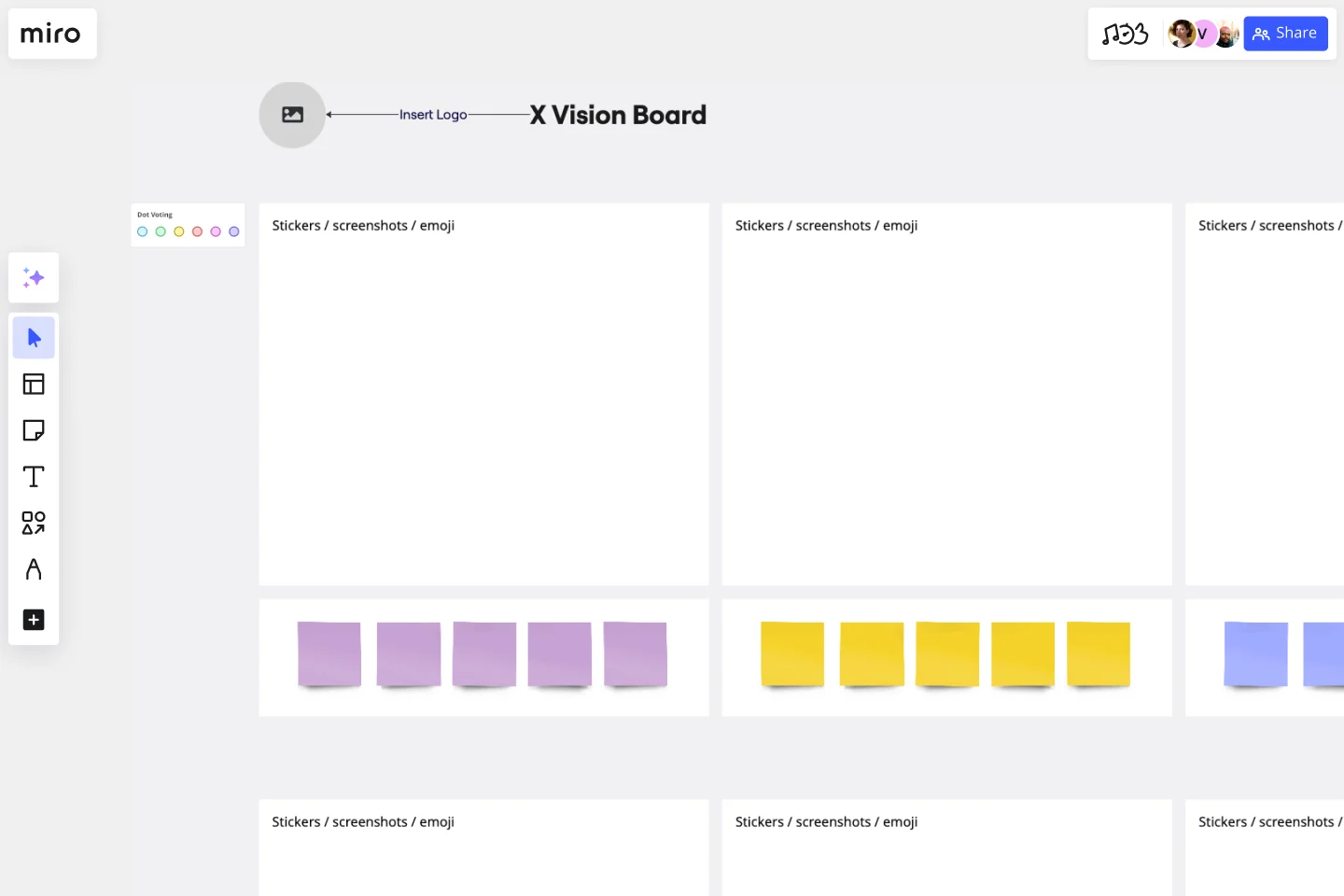Vision Board Template
Shape your project goals and visualize your strategy with Miro’s vision board template. Streamline development and improve collaboration, transforming ideas into achievable milestones.
About the Vision Board Template
Miro's vision board template helps teams align strategic planning and execution of project goals. The template offers a cohesive and visual workspace for any professional to picture and realize their visions.
What's a vision board template?
A vision board template is designed to help anyone visualize, strategize, and execute project goals.
Visual representation: At its core, a team vision board template is perfect for displaying your project goal. It allows teams to map out concepts and designs. Visual cues, images, and symbols can be used to create an intuitive understanding of project goals and the path to achievement.
Integration of resources: The template can seamlessly integrate various artifacts, including documents, spreadsheets, links to research papers, design prototypes, and more. This consolidation of resources ensures that all essential information is readily accessible, fostering informed decision-making and streamlined execution.
Collaborative workspace: One of the primary strengths of the vision board template is its collaborative essence. Team members can interact in real time, editing, commenting, and updating the board to reflect ongoing progress and changes. This improves communication and ensures alignment across different departments and roles involved in the project.
Customization and flexibility: Miro's vision board template is designed to adapt to the unique requirements of different products and industries. Users can add, remove, or rearrange elements, ensuring that the board accurately reflects the nuances and complexities of the project being managed.
Strategic alignment: The template functions as a strategic guide, providing a clear direction for creating a roadmap for your project. It assists in aligning various stakeholders, including designers, developers, marketers, and executives, around a unified vision. Outlining key milestones, responsibilities, and timelines supports systematic planning and prioritizes efforts toward critical objectives.
How to use a vision board template in Miro
To use the vision board template in the context of project management, follow these steps:
Add images: Add visual elements representing different stages or aspects of the project.
Insert links: Embed hyperlinks to relevant documents, web pages, or resources that provide detailed information or guidelines.
Include artifacts: Attach files such as specifications, prototypes, or design documents relevant to the project.
Outline the strategy: Use the text tool to define objectives, timelines, and responsibilities, ensuring alignment with the overarching project vision.
The template is flexible to suit your specific project needs and industry standards, empowering teams to conceptualize, plan, and deliver projects efficiently. Miro's vision board creator helps you bring your product vision to life.
How can multiple team members collaborate using the vision board template?
Miro's team vision board template facilitates real time collaboration, allowing team members to view, edit, or comment, fostering a holistic approach to project management.
Are there any restrictions on the content that can be added to the vision board?
While the template is designed to accommodate various elements, maintaining a balanced and focused approach is advisable for optimal usability and efficiency.
Get started with this template right now.
Fishbone Diagram for Healthcare
Works best for:
Fishbone Diagram
Ensuring high-quality care in healthcare settings requires a thorough understanding of root causes behind issues. The Fishbone Diagram for Healthcare template helps you analyze potential causes of problems in areas like patient care, staff performance, and administrative processes. This structured approach facilitates comprehensive analysis and collaborative problem-solving, ultimately leading to improved healthcare outcomes and patient satisfaction.
Recruitment Strategy Roadmap
Works best for:
Roadmap, Planning, Mapping
The Recruitment Strategy Roadmap template helps organizations plan and execute their talent acquisition initiatives effectively. It provides a structured framework for identifying hiring needs, sourcing candidates, and evaluating recruitment channels. By aligning recruitment efforts with business objectives, organizations can attract and retain top talent, driving organizational growth and success.
B2B – Product Journey Map & User Network
Works best for:
Planning, Product Management
The B2B Product Journey Map & User Network template helps product teams visualize and understand the complex journey of B2B customers. By mapping user interactions, pain points, and touchpoints across the buyer's journey, this template provides insights into user behavior and preferences. With sections for analyzing user needs, identifying opportunities, and optimizing user experiences, it enables teams to design tailored solutions and drive customer satisfaction. This template serves as a strategic tool for enhancing B2B product offerings and maximizing customer value.
Data Migration Plan Template
Works best for:
Data Migration, Planning
The Data Migration Plan Template is a useful tool for any data migration project, providing a simple and flexible structure. The template outlines the various stages of data migration and can be customized to meet the specific needs of your project. This ensures that the plan remains relevant and effective regardless of the scale or complexity of the migration.
Flyer Maker Template
Works best for:
Design, Marketing
Whether it’s a client party or a nonprofit fundraiser, your event needs one key thing to be a smashing success: people to show up. That’s why promoting it is such an important part of the planning—and creating and sending a flyer is the first step. These single-page files will grab your guests’ attention and give them the key details, such as the time, date, and location (and if it’s a fundraiser, who/what the funds will benefit). This template will let you lay out text and customize a flyer design.
DevOps Roadmap Template
Works best for:
Documentation, Product Management, Software Development
DevOps teams are constantly creating code, iterating, and pushing it live. Against this backdrop of continuous development, it can be hard to stay abreast of your projects. Use this DevOps Roadmap template to get a granular view of the product development process and how it fits into your organization's product strategy. The DevOps Roadmap lays out the development and operations initiatives you have planned in the short term, including milestones and dependencies. This easy-to-use format is easily digestible for audiences such as product, development, and IT ops.
